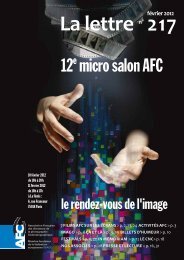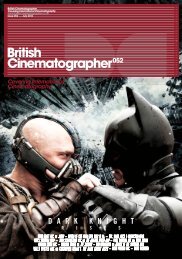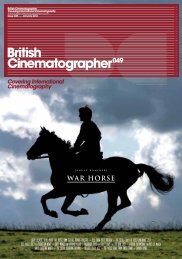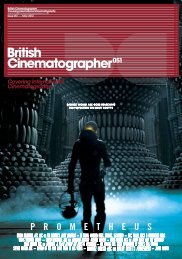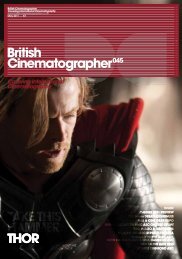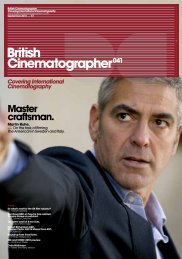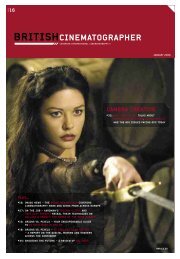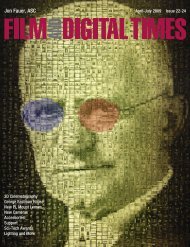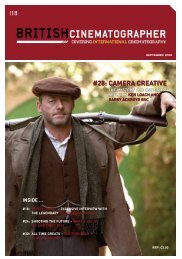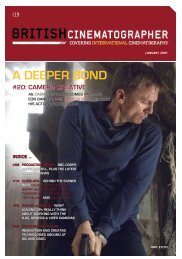You also want an ePaper? Increase the reach of your titles
YUMPU automatically turns print PDFs into web optimized ePapers that Google loves.
Camera: Work in Progress<br />
A big surprise came at the end of Juan Martinez’s Sony PMW-F3<br />
SMPTE presentation in New York. With a deadpan delivery, Juan<br />
announced, “And here’s a little something we’re working on.” The<br />
work-in-progress is called Sony NXCAM 35. A few hours later, it<br />
was shown to the Hollywood industry at a USC presentation, and<br />
shortly after, at InterBEE.<br />
The NXCAM 35 will be a tiny E-mount interchangeable lens<br />
digital motion picture camera with a Super 35mm format CMOS<br />
sensor. As part of Sony’s professional NXCAM line, it will be<br />
available in the middle of 2011, presumably after a big splash at<br />
NAB. Price was rumored to be under $6,000. The pictures here<br />
are pre-prototype models; the actual product might be something<br />
completely different. I assume a handgrip, viewfinder, battery,<br />
and microphone will be appended somewhere.<br />
While the Sony PMW-F3 has an EX style mount (with a PL<br />
adaptor), the NXCAM 35 uses a Sony E-mount. This is the same<br />
mount on Sony’s new digital still cameras, NEX-5, and NEX-<br />
3, and the consumer/prosumer “Handycam” NEX-VG10. The<br />
NXCAM 35 will have the same 18 mm flange focal depth and has<br />
a similarly sized APS-C (23.4 x 15.6 mm) sensor. You should be<br />
able to mount almost any 35mm format still or cine lens on the<br />
planet by using adaptors. Next year could be a good one if you<br />
happen to make lens adaptors.<br />
The new camera will record AVCHD: the same format used in<br />
the HXR-NX5 NXCAM camcorder. On the table are plans to<br />
do 1080p (60p / 30p / 24p or 50p / 25p). MPEG4-AVC/H.264<br />
compression will be used.<br />
The NXCAM concept block got me thinking. Where are cameras<br />
headed? How will they be used? What are we learning from the<br />
designs of the past?<br />
Sony’s NXCAM 35 size suggests that, a few years from now,<br />
sensors could be permanently attached to the lens, which would<br />
reduce dust and smudges on the sensor, guarantee flange focal<br />
depth and consolidate multi-mounting standards. The lens and<br />
sensor unit would attach to the recording and viewing “box.”<br />
Speaking of boxes, that’s what many of the latest cameras resemble.<br />
Camera designers should actually try hand-holding (for many<br />
hours) their creations with some of the heavy lenses that will be<br />
fitted to these boxes. Remember the Arriflex 16SR, 35BL, and<br />
Aaton cat-on-shoulder cameras? They were revolutionary because<br />
they could be comfortably placed on a cinematographer’s shoulder,<br />
eyepiece forward, without the need for cumbersome body pods and<br />
back-bending contortions to balance the weight. These cameras<br />
were also notable for their flexibility. They did not assume everyone<br />
was right handed, right eyed and right shouldered.<br />
An eyepiece should be sharp enough to see critical focus, and<br />
work for either eye. Handgrips should mount directly to either<br />
side of the camera body, with rosettes or industry-standard ⅜-16<br />
threads. When handheld or shoulder-resting, camera operators<br />
often like a load as light as possible: no baseplate, no rods, no<br />
mattebox—just handgrips and a clip-on sunshade.<br />
Is this the end of high-end, expensive cameras? I don’t think so.<br />
The high-end will continue to push the envelope, with greater<br />
resolution, range and results. After all, we’re not all driving<br />
Skodas and Smartcars. There is a thriving market for Mercedes,<br />
Maybachs, Lexus, Lamborghinis, and other high-end vehicles.<br />
Dec 2010<br />
29



